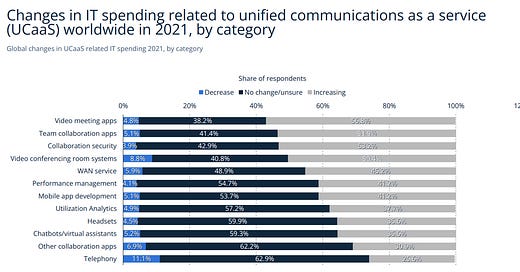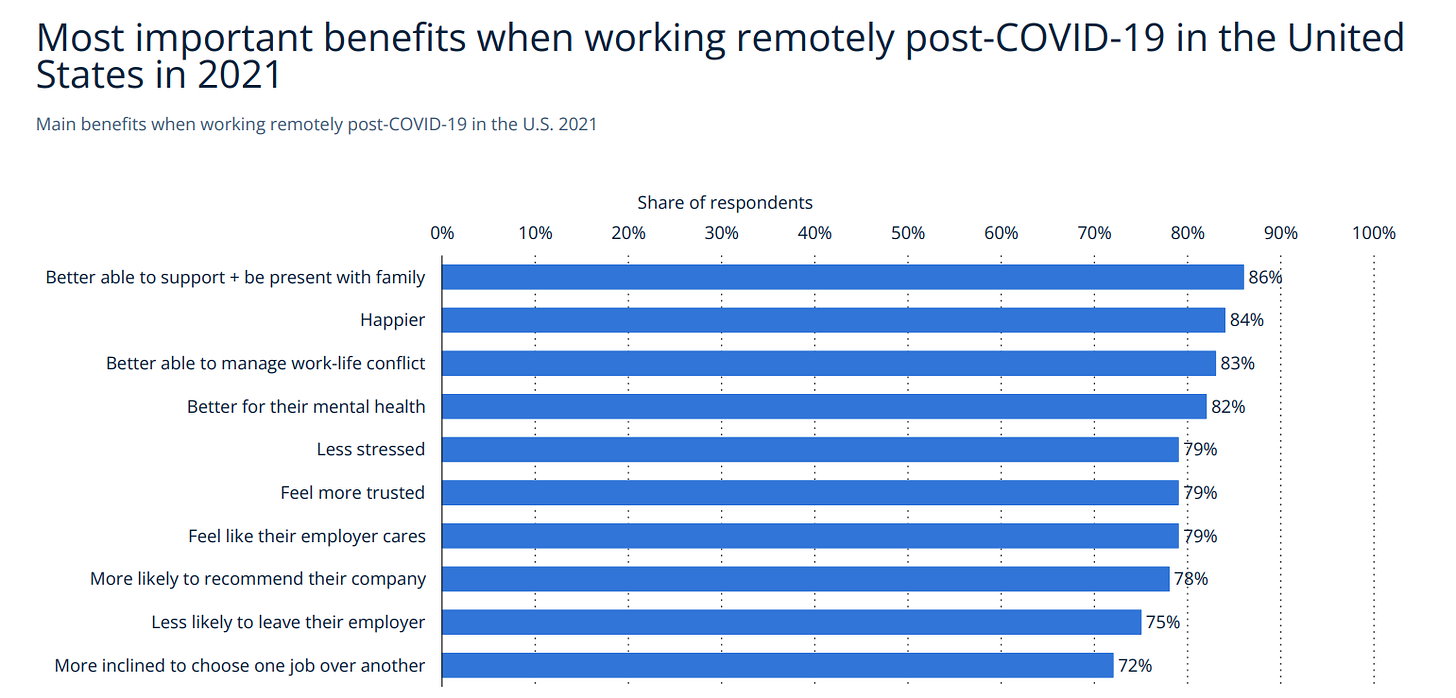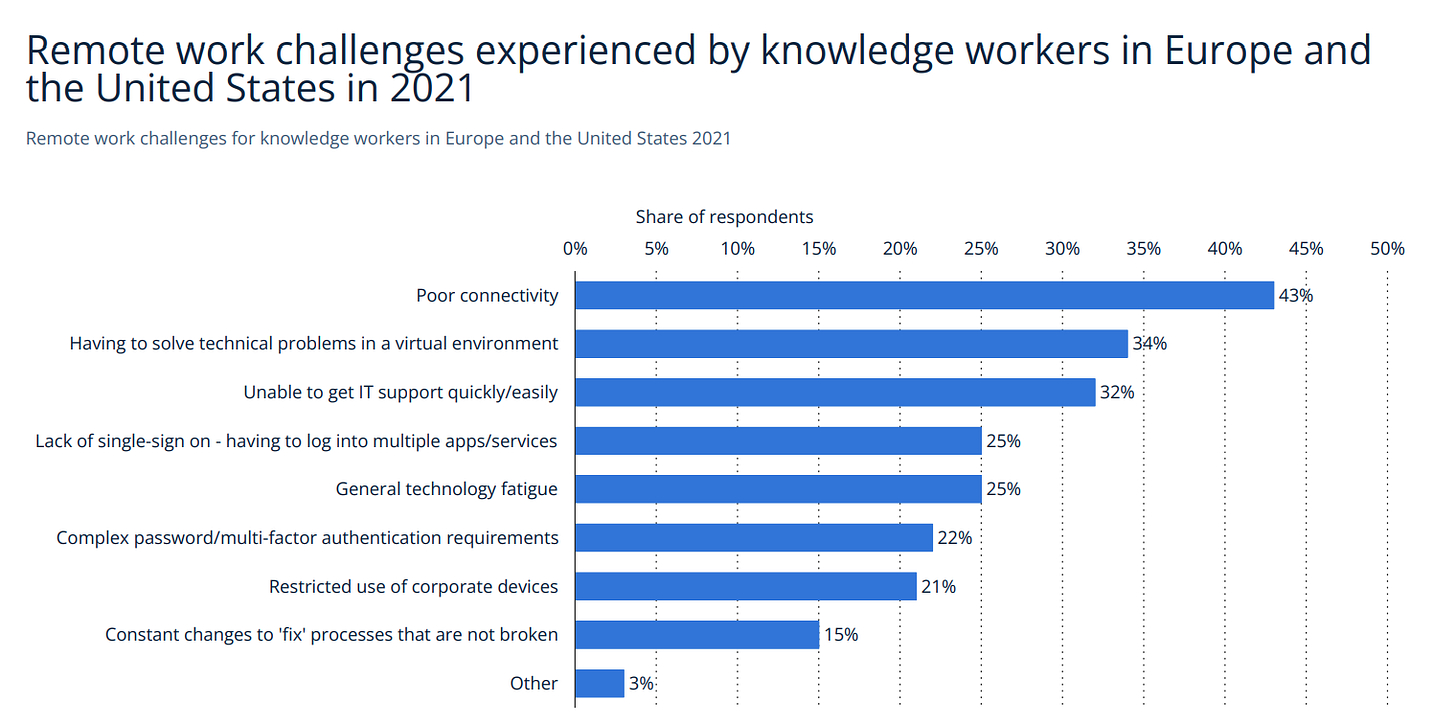This week’s newsletter covers remote, hybrid, and in-office work as opinions of employees and employers have gotten a chance to adapt to these ideas over the last 2 years.
Overview
Remote work was catalyzed by the Covid-19 pandemic, which forced employees to stay home if possible. Software companies in particular were far better off than other sectors like manufacturing, healthcare, restaurants, and malls because most of a software engineer’s work is on a computer, which can be used in a variety of locations.
The more interesting part of the shift to remote work is that non-tech companies such as those in finance, legal, and consulting were traditionally in-office jobs because of the need for collaboration, though many of the reasons also stemmed from legacy work environments that never had enough support or significant catalysts to move fully remote. Covid-19 gave employees the ability to work from home without risking their jobs; companies had no other choice but to let employees work remotely.
A New Paradigm
After the many waves of the pandemic, companies slowly began bringing employees back into the office, either full-time or hybrid. However, as the world has discovered the perks of remote work, this new paradigm has normalized what a regular work day looks like. Furthermore, there are clear metrics that show employees would prefer to have jobs with flexibility of working remotely over jobs that require them to be in the office.
Here’s a chart showing what percent of companies are increasing, decreasing, or not changing their spending on technologies for remote work.
Across the board, there has been more increase in spending than decrease, which reflects the adoption of remote & hybrid work environments. Video meeting apps, collaboration apps, and even chatbots and virtual assistants are seeing increased spending as companies strive to keep their workforce productive and automate as much as possible while keeping communication flowing as good as or better than in-office work had.
Employees Demand Remote Work
A survey from CapRelo below shows that 87.4% of respondents indicate remote work is important to their future employment decisions.
Meanwhile, 8.2% are undecided on what they want, and 4.4% say it’s basically unimportant. Some reasons as to why so many people are considering remote work are illustrated in the following charts.
The top reason revolves around safety and quality of life. For example, not having to commute in a car, train, or bus every day saves people time and reduces risk of accidents.
Flexibility is the biggest benefit of working remotely, and employees feel it in various ways including flexible locations, times to work, environmental factors like music or television, and even what to eat.
A slightly different question from another survey than the previous chart shows that being present to support their family and improved mental health with less stress are some of the biggest benefits of remote work.
Challenges
While remote work may appear to be highly appealing, there are additional challenges to this transition to remote work, as seen by the following survey from Citrix and Sapio Research.
Poor connectivity, debugging/troubleshooting in a virtual environment, and IT workers being “away” or not at their desk resulted in some of the biggest challenges for working remotely. Effectively, there are many more variables at play that need to be accounted for in order for remote work to succeed. Information flow, and therefore productivity in many cases, comes to a complete halt if the internet connection dies. At least employees could go talk about work-related things in the office when similar situations occurred.
This other chart showcasing a survey by Express VPN and Pollfish states that employees suspect their employers to be monitoring a number of activities to ensure they are being productive.
While these stats may have grown since the shift to remote work, it could be possible that many if not all of these surveillance activities were present even before the shift. It may be that employees are simply more cautious and aware of these things now that there is a bigger concern that employers cannot always observe what their employees are doing.
Additionally, a number of advocates for in-person work environments often mention the following reasons in support of their views:
It is often easier to build camaraderie, friendships, and rapport with colleagues in in-person environments.
Cross-team collaborations with diagramming & whiteboarding sessions are often easier to do in-person instead of attempting to draw diagrams without a stylus on a laptop trackpad.
Some leaders have concluded that employee retention reduced during the remote work environment that coincided with the coronavirus pandemic, particularly in technology companies.
Remote work may actually lead to more work and longer work hours. With an “always on” mentality with technological connectivity, some remote workers have flexibility in their work hours, although this flexibility can lead to work messages, emails, and meetings being sent and scheduled throughout the day and night.
Historically, accomplishments of consequence, creativity, and excellence have often occurred in in-person collaborations & teamwork. Here are 3 examples:
NASA launched men to the moon via in-person work, not via remote work.
Tesla jumpstarted and led the movement around the electrification of vehicles via in-person work.
Coronavirus vaccine manufacturing and the logistics around vaccine distribution were accomplished via in-person work.
Conclusion
Overall, the shift to remote work appears to be gaining traction and companies continue to invest in technologies to help their teams collaborate virtually while employees continue to enjoy the flexibility of working remotely. As more companies continue to offer this flexibility, the more they will normalize it. Based on the challenges of remote work, there are still many infrastructural improvements that need to be made to improve the experience for both, employees and employers. Additionally, some tensions or collaborations may arise related to a company’s preferences vs. individual preferences regarding in-person work vs. hybrid work vs. remote work. Individual choice matters, and individuals with multiple job opportunities can select the category of employer that aligns with their values and work environment preferences.
References:
https://www.statista.com/study/66179/dossier-work-from-home-and-remote-work/
This letter is not an offer to sell securities of any investment fund or a solicitation of offers to buy any such securities. An investment in any strategy, including the strategy described herein, involves a high degree of risk. Past performance of these strategies is not necessarily indicative of future results. There is the possibility of loss and all investment involves risk including the loss of principal.
Any projections, forecasts and estimates contained in this document are necessarily speculative in nature and are based upon certain assumptions. In addition, matters they describe are subject to known (and unknown) risks, uncertainties and other unpredictable factors, many of which are beyond Drawing Capital’s control. No representations or warranties are made as to the accuracy of such forward-looking statements. It can be expected that some or all of such forward-looking assumptions will not materialize or will vary significantly from actual results. Drawing Capital has no obligation to update, modify or amend this letter or to otherwise notify a reader thereof in the event that any matter stated herein, or any opinion, projection, forecast or estimate set forth herein, changes or subsequently becomes inaccurate.
This letter may not be reproduced in whole or in part without the express consent of Drawing Capital Group, LLC (“Drawing Capital”). The information in this letter was prepared by Drawing Capital and is believed by the Drawing Capital to be reliable and has been obtained from sources believed to be reliable. Drawing Capital makes no representation as to the accuracy or completeness of such information. Opinions, estimates and projections in this letter constitute the current judgment of Drawing Capital and are subject to change without notice.











